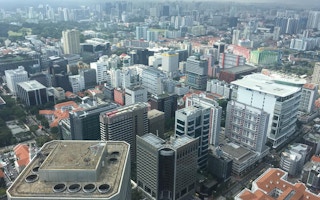Four months ago, a company not particularly well known in the world of fashion, Dell Technologies, launched a line of jewellery made from gold salvaged from the guts of discarded computers.
This venture came a little over a year after the US$13.5 billion computing firm launched an ambitious plan to collect plastic trash bound for the ocean and use it to make packaging for its top-of-the-range laptops.
The Asia Pacific director of Dell’s global takeback programme, Crystynna Ewe, tells Eco-Business that its recycling operation is not for Dell products alone. It’s open to all businesses—even competitors—in 80 countries around the world, turning plastic and gold in more than 90 products.
“What’s difficult is getting consumers to take advantage of these services and send us back their used computers,” she says. “With less than 15 per cent of e-waste getting recycled globally each year, we want to change that statistic—but we can’t do it alone.”
But Dell is not alone in thinking about giving new life to the products it makes and sells. Japanese printing and imaging firm Ricoh designs its products and packaging so that they can easily be recycled.
Last year, the Tokyo-headquartered company introduced new recyclable eco packaging for its copiers that was stronger, more durable and 45 per cent lighter than the previous material, which will save 91.2 tons of materials and 153.7 tons of CO2 emissions a year.
The company has also been working to refine its manufacturing processes, with innovations including using waste plastic that can’t be recycled and converting it into oil, which is used as fuel to generate electricity.
Ricoh also uses scrap metal from electric furnace steel sheets to make multi-function printers and biomass-based plastic as an alternative to the petroleum variety.
To adopt this circular thinking, businesses need to first work out what impact such measures will have on their operations, customers and the bottomline, and make sure that there is a framework in place to support it, Ricoh Asia Pacific’s general manager, service and environment division, JD Kasamoto, tells Eco-Business.
“
Before businesses decide to adopt circular economy principles, they need to assess the impact on their customer base, bottomline, business operations and whether there is the necessary framework to support the transformation.
JD Kasamoto, general manager, service and environment division, Ricoh Asia Pacific
Singapore’s development goals
Much depends on the ability of businesses to innovate to meet the United Nations’ Sustainable Development Goals (SDG), a set of ambitious targets created to make a cleaner, greener, fairer world by 2030.
Driving innovation is one of the principles behind Goal 9, which aims to have created resilient infrastructure and sustainable industries over the next 12 years.
By 2030, infrastructure such as roads, sanitation, electricity, water and computing will be accessible to all, even in the developing world. And industries, even old, polluting sectors like energy, construction and agriculture, will be resource-efficient and use clean, green technologies.
How to achieve SDG 9 in the Singapore context is the focus of this year’s Eco Action Day (EAD) Industry Roundtable, an event organised by Ricoh Asia Pacific that will see 50 business, government and civic society leaders meet to discuss how companies can apply the principles of SDG 9 in their operations in a year the government has declared the Year of Climate Action.
Singapore is one of the world’s safest, most efficient and prosperous cities, but growth of industry and infrastructure in the land scarce city-state has not come without environmental and social cost.
EAD will be looking to find ways that Singapore’s industries can be made more sustainable and inclusive, and how companies can better manage the lifecycle of their products.
The event will see Ewe of Dell and Kasamoto of Ricoh share their experience on how businesses can turn the waste they create into a resource, the main principle of the circular economy.
The biggest obstacle to driving the circular economy in Singapore, says Maggie Lee, market transformation manager at World Wide Fund for Nature (WWF) Singapore, who will also join the debate at EAD, is getting corporate buy-in.
She points to the efforts of British companies such as Tesco, Sainsbury’s and Marks & Spencer, who have “owned up to their responsibility to oversee the entire life cycle of their products,” as all too rare in Singapore and the wider region.
Companies that are not thinking about sustainability risk missing out on business opportunities, notes Lee. Asian businesses could make up to US$5 trillion from the SDGs, according to the 2017 Better Business, Better World report.
SDG 9 presents opportunities such as finding ways to serve the 2.6 billion people in the developing world without electricity, the 2.5 billion people without basic sanitation, 800 million people without clean water, and 1.5 billion people without a mobile phone.
In Singapore, the opportunities are different, but the city-state’s rising population and limited natural resources mean that shifting to a circular economy is key to its sustainable development and future prosperity.
Speakers at last year’s EAD noted that a behaviour shift was needed to reframe waste as a resource, and more investment needed to go into business models and technologies that support the circular economy.
EAD this year will ask: what will industry and infrastructure in Southeast Asia’s most liveable city look like in the future if they are shaped by a circular approach to development? And what will it look like if they are not?
Meanwhile, organisations and individuals can get involved with EAD by making a pledge to support sustainability initiatives in Singapore and “Green the red dot”. Each pledge will be included in the Ministry of the Environment and Water Resources’s list of pledges in support of the Year of Climate Action.











